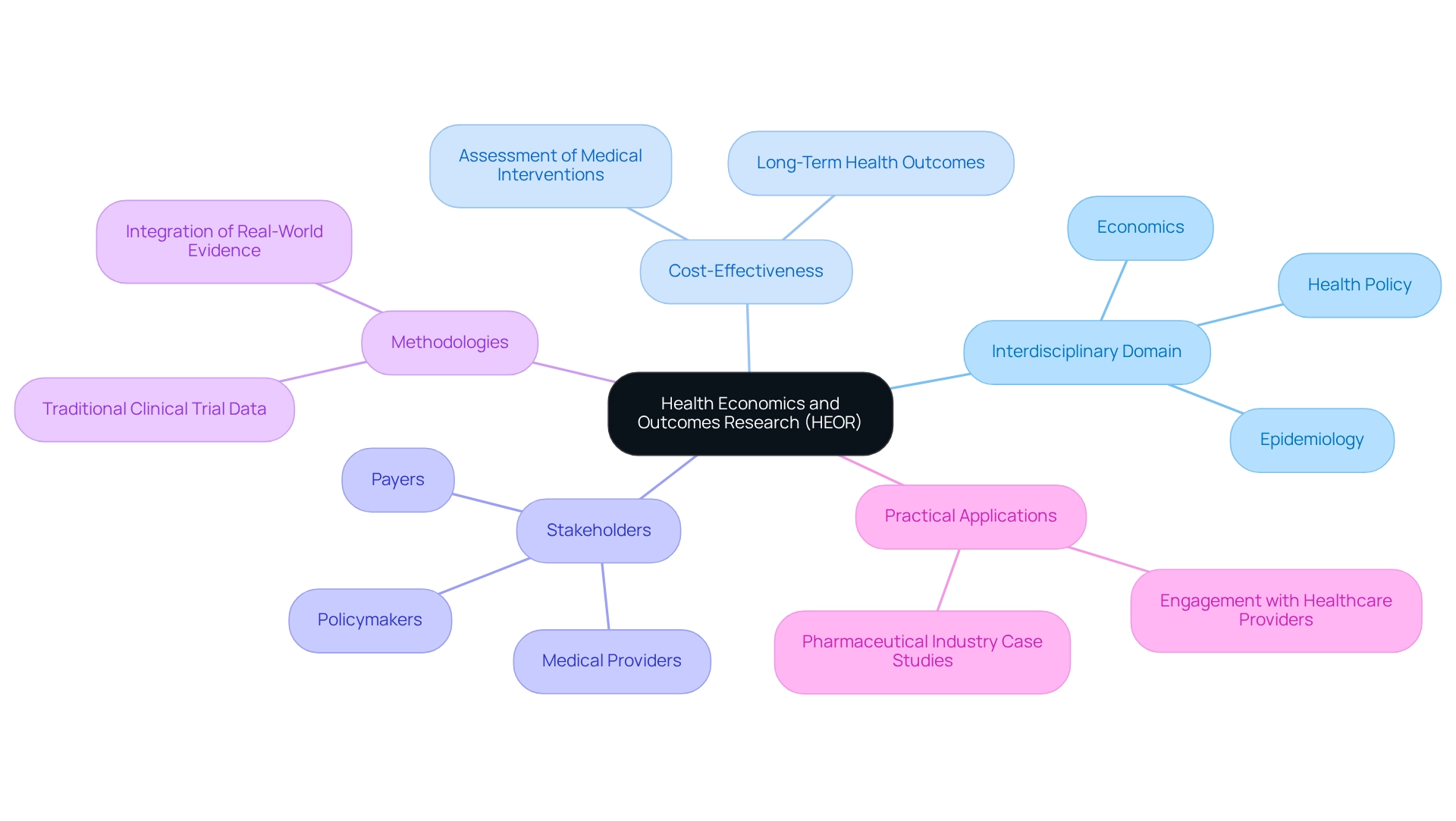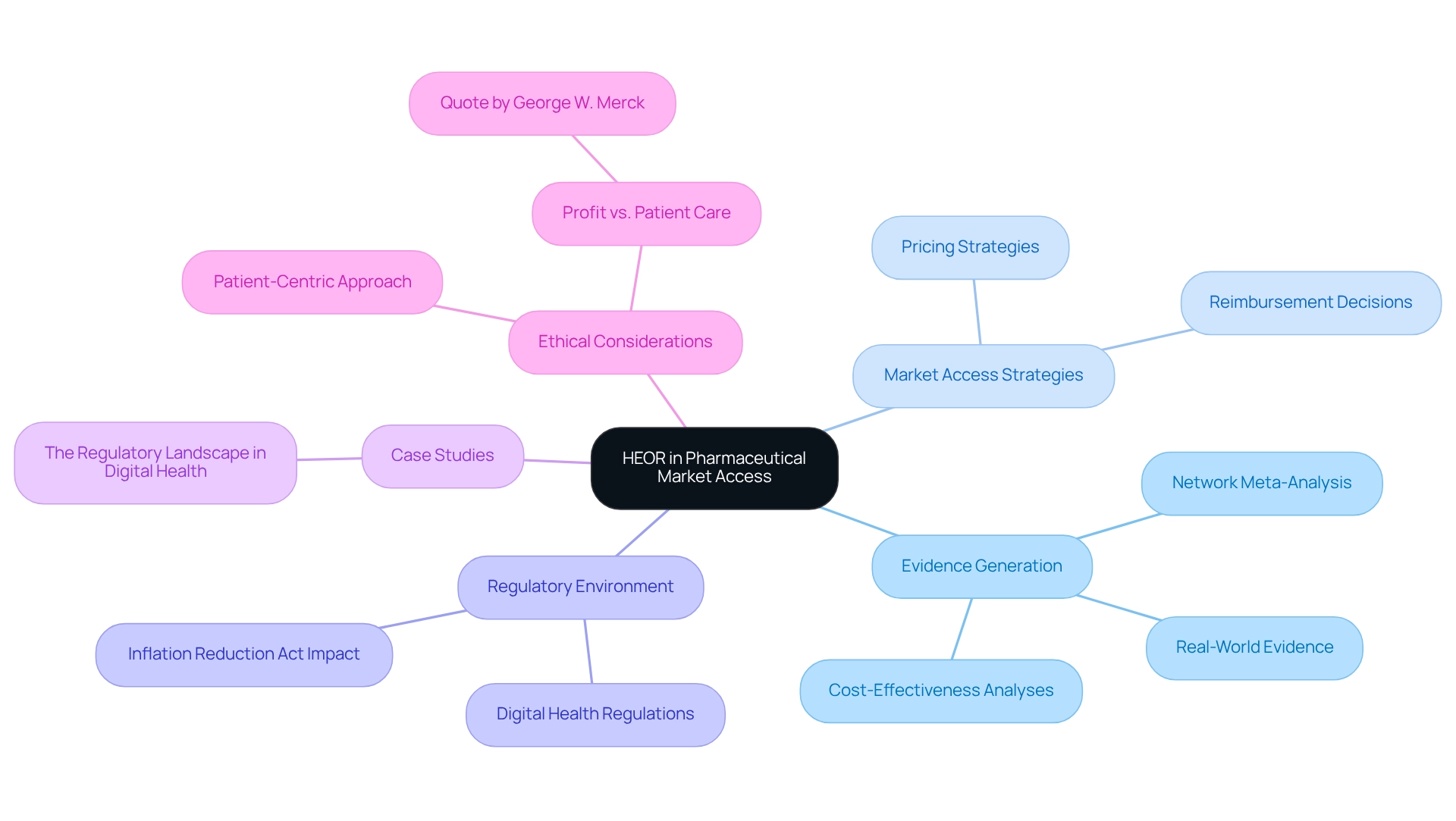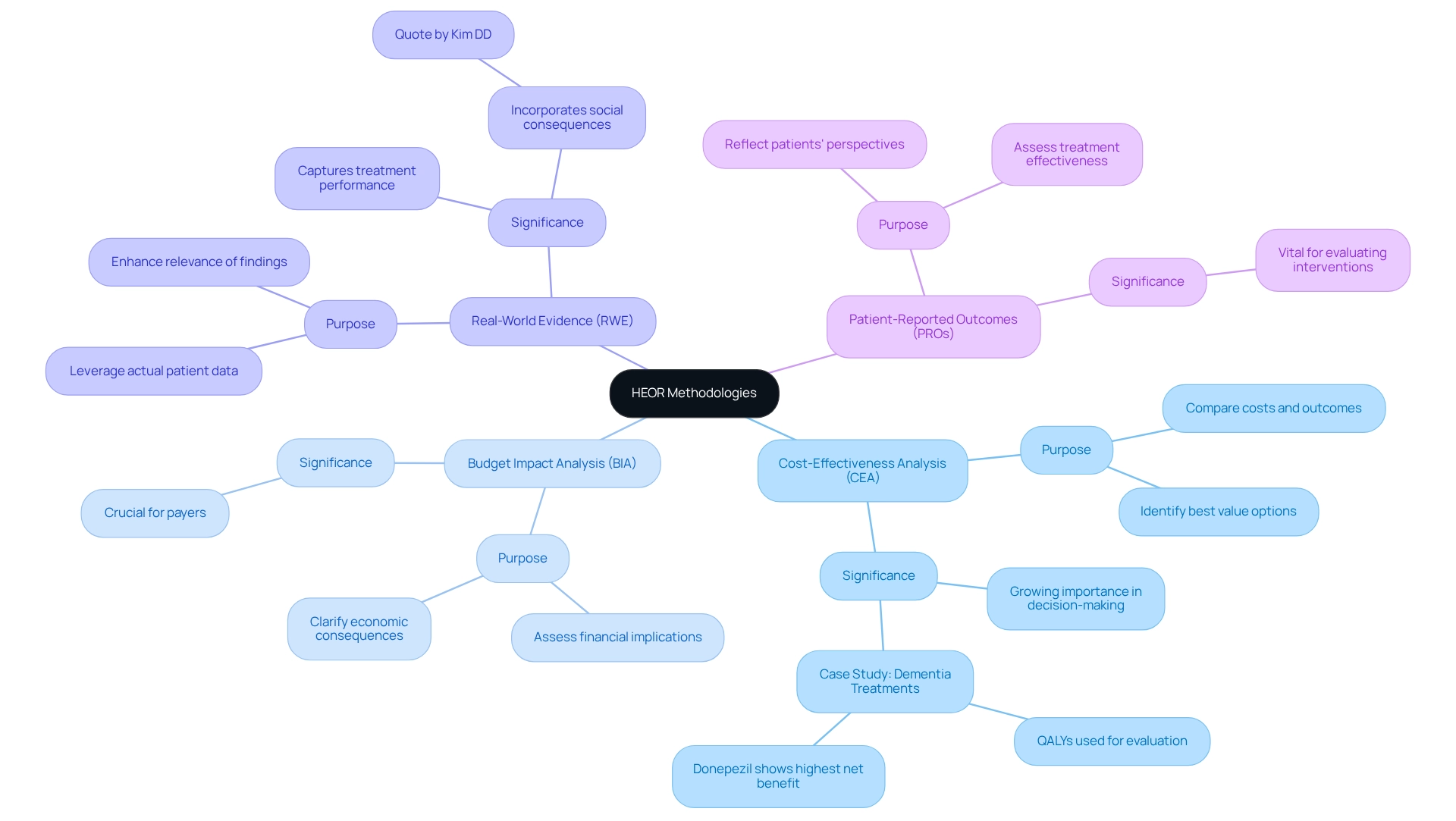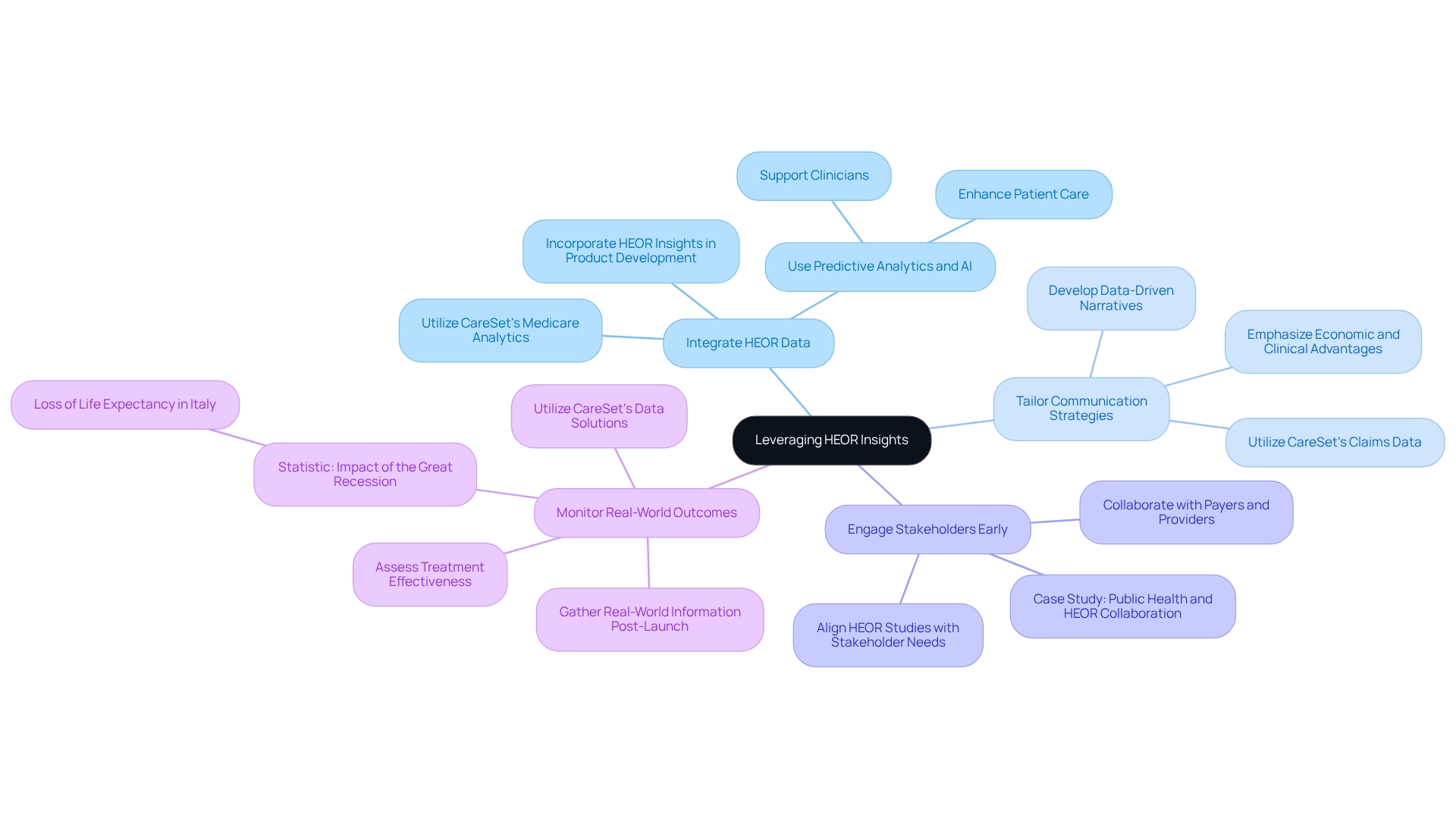Overview
This article delves into strategies for enhancing pharmaceutical market access through Health Economics and Outcomes Research (HEOR), highlighting its pivotal role in demonstrating the value of new drugs to payers. By integrating robust evidence from methodologies such as cost-effectiveness analysis and real-world evidence, HEOR empowers pharmaceutical companies to effectively communicate both clinical and economic benefits. This communication is crucial as it influences reimbursement decisions and ultimately improves patient outcomes. The significance of HEOR cannot be overstated; it serves as a bridge between pharmaceutical innovation and market viability, ensuring that new therapies are not only effective but also justifiable in their costs.
Introduction
In the rapidly evolving landscape of healthcare, Health Economics and Outcomes Research (HEOR) has emerged as a pivotal force in shaping effective healthcare strategies. By integrating economic analysis with patient outcomes, HEOR offers invaluable insights that inform decision-making for stakeholders, including pharmaceutical companies and policymakers. As the demand for value-based care intensifies, the role of HEOR becomes increasingly critical, guiding resource allocation and enhancing patient care.
This article explores the multifaceted applications of HEOR, examining its methodologies, its impact on pharmaceutical market access, and the strategies organizations can adopt to leverage HEOR insights for improved outcomes and business success.
Define Health Economics and Outcomes Research (HEOR)
Health Economics and Outcomes Research stands as an essential interdisciplinary domain, merging economics, epidemiology, and health policy to evaluate the worth of medical interventions. It emphasizes the assessment of cost-effectiveness, individual outcomes, and the overall efficiency of medical systems. By providing robust evidence, health economics and outcomes research informs decision-making among stakeholders such as medical providers, payers, and policymakers, ensuring effective resource allocation to enhance patient care and health outcomes.
In 2025, expert perspectives underscore the significant role of health economics and outcomes research in shaping medical strategies. As medical systems increasingly prioritize value-oriented care, the demand for comprehensive health economics and outcomes research data has surged. Current statistics reveal that effective practices in health economics and outcomes research profoundly influence medical decision-making. Studies indicate that organizations leveraging these insights can improve patient outcomes and optimize resource allocation. For instance, CareSet integrates over 100 external information sources into its analysis, enhancing the depth and reliability of health economics and outcomes research methodologies while addressing critical medical inquiries such as ‘Who influences adherence?’ and ‘How does the IRA affect Medicare Part D Coverages and Costs?’
Current trends in health economics and outcomes research methodologies involve the integration of real-world evidence alongside traditional clinical trial data, facilitating a more nuanced understanding of treatment effectiveness across diverse populations. This shift is crucial as it aligns with the growing emphasis on personalized medicine and patient-centered care, further supported by CareSet’s extensive Medicare analytics solutions that empower stakeholders in the medical field.
Case studies illustrate the practical applications of health economics and outcomes research within the pharmaceutical industry. The importance of HEOR information has been highlighted in discussions among medical affairs experts, who benefit from grasping health economic principles to engage effectively with health service providers through HEOR. Such insights foster informed dialogues regarding the economic implications of new therapies, ultimately leading to enhanced care and strategic healthcare decisions. CareSet’s data analytics have played a pivotal role in these discussions, offering actionable insights that bolster engagement and decision-making.
As Tony Culyer aptly noted, “Show respect for aged health economists: they’ve probably forgotten more health economics than you’ve ever learned!” This sentiment encapsulates the depth of knowledge and experience within the field, underscoring the necessity for continuous dialogue and learning.
The fundamental principles of health economics and outcomes research encompass the analysis of treatment costs relative to their benefits, the evaluation of long-term health outcomes, and the incorporation of individual perspectives in economic assessments. These principles are vital for developing effective health economics and outcomes research (HEOR) strategies that enhance medical interventions and support informed decision-making, particularly through the lens of CareSet’s Medicare insights.
In summary, Health Economics and Outcomes Research is not merely a tool for economic analysis; it is a cornerstone of contemporary medical decision-making, driving improvements in care for individuals and ensuring that medical interventions deliver both clinical and economic value.

Explore the Role of HEOR in Pharmaceutical Market Access
HEOR is pivotal in shaping pharmaceutical market access by generating robust evidence that substantiates the value proposition of new drugs. It empowers pharmaceutical companies to communicate effectively the clinical and economic advantages of their products to payers, thereby influencing reimbursement decisions. Through comprehensive cost-effectiveness analyses and budget impact models, HEOR teams illustrate how innovative therapies can enhance outcomes for individuals while ensuring they remain financially viable for medical systems. This evidence is crucial during payer negotiations and can significantly determine a drug’s market entry and adoption trajectory.
Furthermore, CareSet’s extensive Medicare information solutions, encompassing insights from over 62 million beneficiaries and 6 million providers, deliver actionable insights essential for understanding patient needs, provider networks, and pharmaceutical utilization. These insights inform strategic medical decision-making. CareSet’s information includes over $900 billion in claims and 14+ years of claims history, enhancing the depth of analysis available to healthcare stakeholders. Insights from health economics and outcomes research (HEOR) play a critical role in developing pricing strategies and informing clinical trial designs, ensuring that the data collected meets payer expectations. Recent statistics indicate that health economics and outcomes research evidence increasingly influences reimbursement decisions, with a notable shift in 2025 towards integrating real-world evidence into payer evaluations. The Inflation Reduction Act of 2022, which allows Medicare to negotiate medication costs and restrict price hikes, further underscores the significance of health economics and outcomes research (HEOR) in navigating this evolving landscape.
Case studies, including those exploring the regulatory environment in digital health, emphasize the necessity for clear regulations to promote the adoption of digital therapeutics, further highlighting the impact of health economics and outcomes research on market access. As George W. Merck stated, “We try to remember that medicine is for the patient. We try never to forget that medicine is for the people. It is not for the profits.” This perspective reinforces the ethical dimensions of pharmaceutical practices and the patient-focused approach that health economics and outcomes research embodies.
Additionally, network meta-analysis serves as a pertinent statistical approach that HEOR teams can employ to compare the effectiveness of various interventions, thereby enhancing their analyses. As the medical landscape evolves, the insights derived from health economics and outcomes research, supported by CareSet’s comprehensive data solutions—including the NPI-labeled provider network and the absence of blackout markets—will continue to be instrumental in advancing patient care by facilitating access to innovative therapies and translating these advancements into clinical practice.

Examine HEOR Methodologies and Data Utilization
HEOR employs a diverse array of methodologies to effectively evaluate the value of medical interventions. Key approaches include Cost-Effectiveness Analysis (CEA), Budget Impact Analysis (BIA), Real-World Evidence (RWE), and Patient-Reported Outcomes (PROs).
Cost-Effectiveness Analysis (CEA) compares the costs and outcomes of different interventions, enabling stakeholders to identify which options deliver the best value for money. Notably, three out of the top ten most cited CEAs were published in the latter half of the 2000s, underscoring the growing importance of this analytical approach in the field. This trend emphasizes the increasing acknowledgment of CEA as an essential instrument for decision-making in the medical field.
Budget Impact Analysis (BIA) assesses the financial implications of adopting new interventions within specific budgetary constraints. This analysis is crucial for payers as it clarifies the economic consequences of integrating new therapies into existing medical frameworks.
Real-World Evidence (RWE) enhances the relevance of HEOR findings by leveraging data derived from actual patient experiences. This methodology captures insights into treatment performance outside of controlled clinical trials, providing a more comprehensive understanding of medical interventions. As Kim DD highlights, incorporating social consequences in cost-effectiveness analysis is crucial, underscoring the significance of HEOR in assessing medical interventions.
Patient-Reported Outcomes (PROs) reflect patients’ perspectives on their health status and quality of life, offering valuable data on treatment effectiveness from the patient’s viewpoint. This patient-focused approach is increasingly acknowledged as vital in assessing medical interventions. Incorporating these approaches enables health economics and outcomes research (HEOR) to generate strong evidence that guides decision-making in the medical field.
For instance, a recent case study on the cost-effectiveness of dementia treatments utilized Quality-Adjusted Life Years (QALYs) to evaluate four FDA-approved medications. The analysis revealed that all treatments provided positive net benefits, with Donepezil yielding the highest net benefit of USD 193,174 per person. This case study demonstrates how CEA can influence funding choices and enhance treatment options in the medical field.
Furthermore, innovative approaches like the Tailored Activity Program (TAP) have demonstrated significant net benefits, such as USD 7,933 in caregiver time savings. This example illustrates the importance of real-world evidence in health economics and outcomes research studies, demonstrating how practical applications can result in enhanced outcomes for individuals and resource allocation. As the healthcare landscape continues to evolve, the application of these methodologies will remain pivotal in enhancing pharmaceutical market access and improving patient outcomes.

Apply HEOR Insights to Enhance Patient Outcomes and Business Strategies
To effectively leverage HEOR insights, pharmaceutical companies should adopt the following strategies:
- Integrate HEOR Data into Product Development: Incorporating HEOR insights from the outset allows companies to design clinical trials that directly address payer concerns and demonstrate the value of new therapies. As Betsabeh Madani Hermann, Global Head of Research at Philips, states, “By developing predictive analytics and AI algorithms, essential tools for enhancing patient care, we’re empowering clinicians and supporting improved care for more individuals.” CareSet’s advanced Medicare analytics can further enhance this process by providing comprehensive insights that inform product development and align with market needs.
- Tailor Communication Strategies: Develop narratives based on health economics and outcomes research findings that resonate with payers, emphasizing both the economic and clinical advantages of therapies to encourage buy-in. Utilizing CareSet’s extensive claims data, companies can better articulate the value proposition of their therapies, ensuring that communications are data-driven and impactful.
- Engage Stakeholders Early: Collaborating with payers and healthcare providers early in the process ensures that health economics and outcomes research studies are aligned with their needs and expectations, addressing pertinent questions that can influence decision-making. A relevant case study is the collaboration between public health and HEOR professionals, which highlights the need for multidisciplinary approaches to effectively tackle global health challenges. CareSet’s insights can facilitate these early engagements by identifying key stakeholders and their specific needs.
- Monitor Real-World Outcomes: After launching, it is essential to consistently gather and examine real-world information to assess treatment effectiveness across various patient groups. This ongoing assessment enables companies to refine their strategies based on actual outcomes. CareSet’s comprehensive Medicare data solutions provide the necessary analytics to track these outcomes effectively. The significance of strong HEOR strategies is emphasized by the statistic that the ‘Great Recession’ in Italy in 2008 led to a decrease of nearly one year in life expectancy ten years post-crisis, underscoring the essential requirement for efficient economic assessments in the medical field.
By implementing these strategies, pharmaceutical companies can not only enhance patient outcomes but also improve market access and drive overall business success. Explore how CareSet’s comprehensive healthcare data insights can empower your business for strategic growth and informed decision-making.

Conclusion
The exploration of Health Economics and Outcomes Research (HEOR) underscores its critical importance in today’s healthcare landscape, especially within the framework of value-based care. By employing methodologies like cost-effectiveness analysis and real-world evidence, HEOR delivers vital insights that inform decision-making processes across the healthcare spectrum. This focus on patient outcomes coupled with economic evaluations guarantees that healthcare interventions are not only clinically effective but also financially sustainable.
In the sphere of pharmaceutical market access, HEOR serves as a vital link between groundbreaking therapies and payer acceptance. Through rigorous evidence generation, pharmaceutical companies can articulate the value of their offerings, thereby influencing reimbursement decisions and facilitating market entry. By integrating HEOR insights into product development and communication strategies, organizations can better align their offerings with the expectations of payers and healthcare providers, ultimately leading to enhanced patient care.
As the healthcare landscape continues to evolve, the methodologies and data leveraged in HEOR will remain crucial in shaping effective healthcare strategies. Embracing HEOR principles not only propels advancements in patient outcomes but also aids organizations in achieving their business objectives. By harnessing comprehensive data solutions, such as those offered by CareSet, stakeholders can adeptly navigate the complexities of the healthcare environment, paving the way for a future where patient-centric care and economic efficiency coexist harmoniously.


